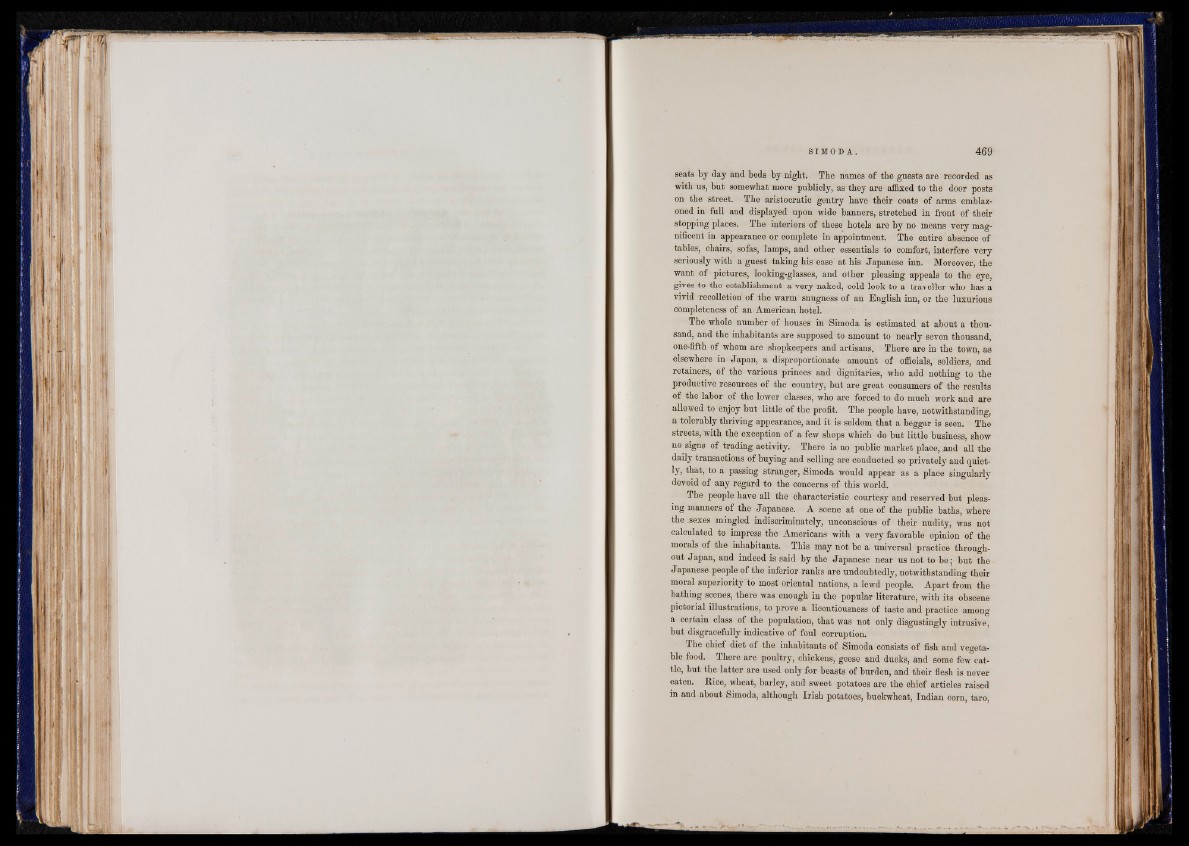
S IMODA.
seats by day and beds by night. The names of the guests are recorded as
with us, but somewhat more publicly, as they are affixed to the door posts
on the street. The aristocratic gentry have their coats of arms emblazoned
in full and displayed upon wide banners, stretched in front of their
stopping places. The interiors of these hotels are by no means very magnificent
in appearance or complete in appointment. The entire absence of
tables, chairs, sofas, lamps, and other essentials to comfort, interfere very
seriously with a guest taking his ease at his Japanese inn. Moreover, the
want of pictures, looking-glasses, and olher pleasing appeals to the eye,
gives to the establishment a very naked, cold look to a traveller who has a
vivid recolletion of the warm snugness of an English inn, or the luxurious
completeness of an American hotel.
The whole number of houses in Simoda is estimated at about a thousand,
and the inhabitants are supposed to amount to nearly seven thousand,
one-fifth of whom are shopkeepers and artisans. There are in the town, as
elsewhere in Japan, a disproportionate amount of officials, soldiers, and
retainers, of the various princes and dignitaries, who add nothing to the
productive resources of the country, but are great consumers of the results
of the labor of the lower classes, who are forced to do much work and are
allowed to enjoy but little of the profit. The people have, notwithstanding,
a tolerably thriving appearance, and it is seldom that a beggar is seen. The
streets, with the exception of a few shops which do but little business, show
no signs of trading activity. There is no public market place, and all the
daily transactions of buying and selling are conducted so privately and quietly,
that, to a passing stranger, Simoda would appear as a place singularly
devoid of any regard to the concerns of this world.
The people have all the characteristic courtesy and reserved but pleasing
manners of the Japanese. A scene at one of the public baths, where
the .sexes mingled indiscriminately, unconscious of their nudity, was not
calculated to impress the Americans with a very favorable opinion of the
morals of the inhabitants. This may not be a universal practice throughout
Japan, and indeed is said by the Japanese near us not to be; but the
Japanese people of the inferior ranks are undoubtedly, notwithstanding their
moral superiority to most oriental nations, a lewd people. Apart from the
bathing soenes, there was enough in the popular literature, with its obscene
pictorial illustrations, to prove a licentiousness of taste and practice among
a certain class of the population, that was not only disgustingly intrusive,
but disgracefully indicative of foul corruption.
The chief diet of the inhabitants of Simoda consists of fish and vegetable
food. There are poultry, chickens, geese and ducks, and some few cattle,
but the latter are used only for beasts of burden, and their flesh is never
eaten. Rioe, wheat, barley, and sweet potatoes are the chief articles raised
in and about Simoda, although Irish potatoes, buckwheat, Indian corn, taro,